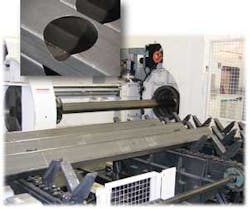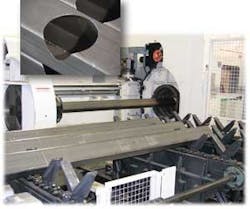Turning tubing into profits
Automated 3D laser processing makes quick work of cut-to-length tubular components
Laureen J. Belleville
In the trough of the Midwest agricultural depression in 1985 Bill Duy started Production Cutting Services (PCS; East Moline, IL) with two employees in a 2000-sq-ft facility. It was a time when big agricultural OEMs were moving from a large-volume philosophy to the smaller, just-in-time (JIT) production. Naively, perhaps, Duy thought he could supply cut-to-length tubular components for these companies.
“We started out as just a saw cutting operation,” explains Duy, company owner and president. “Shortly after the company started doing business, we decided that to survive we had to add more value to the material that we process. We started drilling holes and machining contours.” And that’s also when PCS started to encounter the realities of tube fabricating.
Tubing is difficult to machine-considering tool wear caused by material or tool deflection and vibration during the cutting process. Premature tool wear and breakage can significantly increase production costs. Also, “The tubing industry, especially the structural tubing industry, has set up some very loose guidelines,” says Duy, “so you get a lot of variation in dimension in shaped (square, rectangular) tubing across flats and even variations from one manufacturer to the next as far as sharpness of the corner radii. This creates a lot of problems.”
Additionally, work holding when machining tubing is a major consideration. Generally, the tube is clamped in a vise or fixture while the tool drills or mills the tube. These fixtures can cost hundreds if not thousands of dollars to make for each part that needs to be fabricated. Now, factor in setup time-often from 1.5 to 3 hours. “That goes contrary to what our customers want,” Duy notes. “A large production quantity for us is probably 200 to 300 pieces; a normal quantity is 30 to 40 pieces. When you amortize 30 to 40 pieces across three hours of set up that’s a pretty significant portion of the part’s cost.”
Duy kept his eye on developments in laser cutting technology. “The 3D capability is something we’ve been looking at for quite a long time,” says Duy. “We’ve had some plasma cutting equipment that was relatively inexpensive, but it was a 2D type of machine and not near the level of automation we wanted.” He turned to Mazak for a system that offered true three-dimensional cutting and large tubing size capability.
Mazak responded with the FabriGear 300 and the results of a productivity challenge that pitted the 4000W 3D laser with rotary against a 30hp vertical milling machine (see table). According to Glenn Berkhahn, senior vice president at Mazak Laser Corp. (Schaumburg, IL; www.mazaklaser.com), many customers just compare cutting times and/or machine costs. This comparison does not take into consideration the total time the job is in the shop and what it takes to complete the job. The total time is more critical to meeting delivery lead times and accessing the supporting costs associated with the job. For example, the milling process requires the purchasing of tooling, sharpening of the tooling, loading the tooling onto the machine, and cost and lead time to make fixturing.
The 30hp milling machine is a less expensive option. But this is offset by slower cutting times. To reach laser cutting speeds requires a larger and more expensive milling machine. “How many machining job shops have such a machine and who would want to use it for tubular jobs such as carbon steel that is ½-inch thick,” asks Berkhahn. “It has greater value in processing more sophisticated milling applications.”
Using a laser to make a tubular part according to the print has many benefits, not the least of which is total processing time. It means that more jobs can be processed in the shortest time period. Although they may not want to, companies can hire more people, buy more software and machines, and build more facilities. But, they cannot buy more time. This is what PCS is experiencing. The company has shortened its lead times by using the laser to make the parts according to its customer’s prints-which means there’s more time for other business. According to Duy, job set-up on the FabriGear consists of simply putting different tubing on the input rack and changing the program-a process that he estimates takes 10 minutes.
“My plan over the next year or so is to take the parts that we’re currently doing on large vertical machining centers and move them over to the laser,” explains Duy. “Currently I have almost two shifts of work that fits into that category, and that’s going to free up my vertical machining centers to do work that’s more conducive to being done on them. That will also allow me to market on the FabriGear another shift or shift and a half worth of work for new laser cut parts that engineers might design in the future.”
Additionally shops like PCS are discovering that they can now go beyond making parts according to prints-value-added tubular fabricating, if you will. By adding more features to these parts-such as slots and tabs, hooks and eyes, 45-degree single tube cuts-they can make the parts into self-fixturing assemblies, or combine two parts into one. Adding these features to the design and processing them on a laser is not complicated, but it is profitable. And this is exactly the position a shop like PCS wants to be in-working closely with their customers to produce more value-added parts on a continuous basis.
While Duy acknowledges the substantial monetary investment to acquire the laser system, he notes that there’s a certain risk in not investing. “There’s a lot of competition overseas, and the people in this country that don’t automate or become more productive with their operations could potentially be left behind. You’ve got to differentiate yourself from the competition to be more attractive to your customers.”
Duy’s approach seems to be paying off. The company now boasts 56 employees and, with its most recent addition of 8000 square feet, occupies an 83,000-sq-ft facility. Currently he has four people trained on the FabriGear and his goal is to have six people trained across three shifts so that it can be run around the clock. Interestingly, the laser addition has created a little excitement among the employees, Duy reports. “From a morale standpoint, it excites people to be working around a six-axis laser. They feel they’re on the cutting edge. It’s created some competition within the company to be the one chosen to run the machine.”
PCS continues to plan for the future. Its next step may be a smaller, faster machine that would concentrate on lighter walls and smaller diameters. “I think laser is going to be the optimum way to process tubing,” says Duy.


